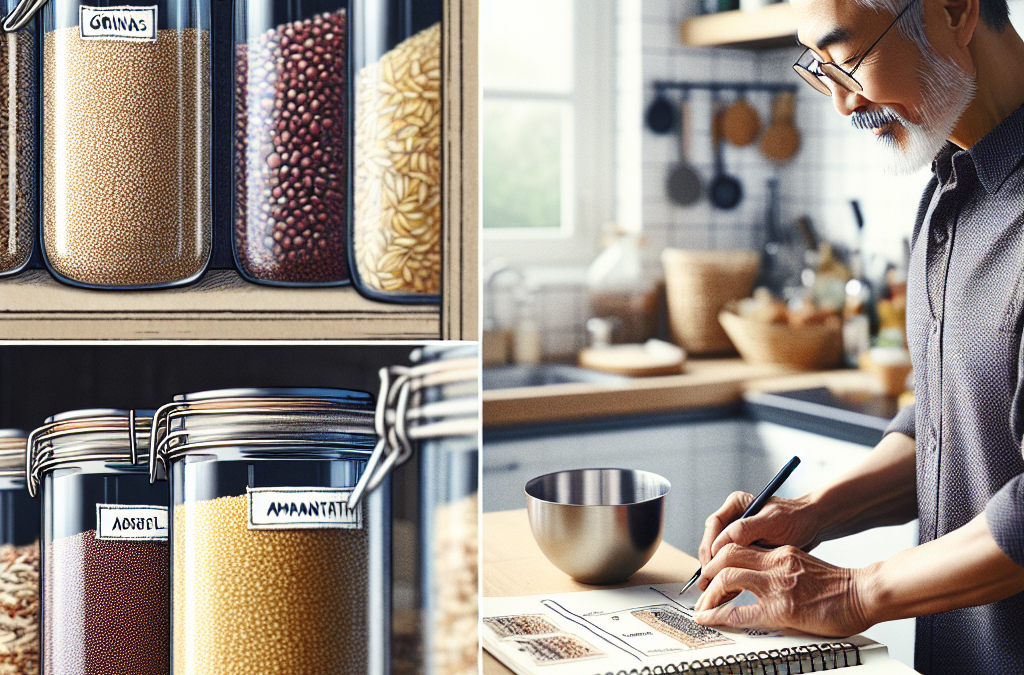Understanding Ancient Grains
The History Behind Ancient Grains
Alright, let’s dive into the fascinating world of ancient grains. These grains have been around for centuries, and they pack a richness in history that’s just as fulfilling as their nutritional benefits. Picture grains like quinoa, amaranth, and farro—these have stood the test of time. They were integral to the diets of ancient civilizations, carrying not just cultural significance but also stories passed down through generations.
When we talk about ancient grains, we’re referring to those that have remained largely unchanged by modern agriculturists. They’re not your common wheat or corn; think of them like the untouched canvas of the grain world. Their resilience in staying true to form is testament to nature’s original nutritional design.
Now, why does this matter? Simple. The less these grains are altered, the more nutrients they retain. So you’re getting food that’s as close as possible to what our ancestors consumed. That’s pretty neat, right?
Differences Between Ancient and Modern Grains
Ever wondered why ancient grains are often hailed as superfoods while modern grains are shunned? It’s all in the processing. Ancient grains have retained their original structure and composition. This means they’ve dodged the aggressive modifications and genetic tweaking modern grains usually undergo. They’re the nonconformists of the plant world, in a good way!
What’s more, because ancient grains are usually whole grains, they boast a higher fiber content. They’ve got all three parts of the grain kernel intact—the bran, germ, and endosperm. This not only makes them nutritionally superior but also means they keep you feeling fuller for longer. Talk about a win-win!
As we live in a fast-paced world with rapidly evolving dietary needs and preferences, embracing grains that connect us to our roots could be a smart choice. They offer naturally higher amounts of vitamins and minerals. Trust me, your body and taste buds will both appreciate the difference.
Popular Types of Ancient Grains
If your curiosity is piqued and you’re ready to stock up, you’ll find that ancient grains offer a lot of variety. Beyond quinoa, there’s teff, a staple in Ethiopian cooking that’s incredibly nutritious. Then there’s spelt, often used in pastas and breads for its nutty flavor. And my personal favorite, farro, a terrific alternative to rice when you’re crafting a hearty salad.
Each of these grains brings something unique to the table. They have different textures, flavors, and cooking times, which makes experimenting in the kitchen a lot of fun. Trying them out is like a mini adventure around the world—all from the comfort of your kitchen!
Next time you’re shopping, take a walk on the wild side. Pick up a bag of millet or kamut. You might just find a new pantry staple that’s not only delicious but also connects you to culinary history. Plus, think of the bragging rights at your next dinner party when you whip up a dish using heirloom grains!
Optimal Storage Techniques for Ancient Grains
Keeping It Cool and Dry
Now, storing ancient grains may seem straightforward, but trust me, there’s a bit of an art to it. The key here is to keep them in a cool, dry place, sheltered from moisture and heat. I like to think of these grains as little treasure troves; you wouldn’t leave treasure out in the rain, right?
Ideally, store them in airtight containers and place them in the pantry. But be mindful—pantries can get pretty warm, especially if they’re near an oven. If you’re in a hot climate, consider putting them in the fridge to extend their shelf life.
Proper storage means less worry about pesky critters or mold. And, since these grains often come in larger quantities, it ensures that you can enjoy them for months to come without sacrificing quality.
Best Practices for Freezing
When it comes to long-term storage, freezing can be your best friend. I often buy these grains in bulk, and freezing is a great option. Just make sure they’re in a moisture-proof, airtight container. Trust me, it’s worth investing in good storage solutions upfront to keep these grains at their best.
Some people might be skeptical about freezing grains, worrying it’ll ruin the texture. But let me tell ya, I’ve had great success with this method. When defrosted and cooked, they maintain their texture perfectly, so you can whip up a tasty meal anytime.
Plus, having a variety of ancient grains in your freezer means more culinary adventures await, without constant trips to the store. It’s perfect for anyone looking to add a bit of ancient flair to their weekday meals without the hassle.
Using Labels and Rotating Stock
This might sound basic, but labeling is key. With my tendency to stock up, it’s really easy for grains to get lost in the pantry shuffle. Write down the name and purchase date of your grains on a label. You’ll thank yourself later, especially when you’re juggling several types.
A handy tip I’ve adopted? The FIFO method: First In, First Out. It ensures you’re always using the older stock first and nothing goes to waste. This way, your pantry stays organized, and you minimize the chances of anything expiring before you get a chance to enjoy it.
The discipline of keeping things labeled and rotated isn’t just good practice for grains but for any pantry item. A little organization goes a long way, and once you get the hang of it, it becomes second nature. Plus, who doesn’t get a little joy from opening an organized pantry?
Creative Ways to Cook with Ancient Grains
Integrating Grains in Breakfast
Breakfast is indeed the meal of champions, and what better way to start than with ancient grains! Quinoa breakfast bowls have become a staple in my morning routine. They’re hearty and can be customized with fruits, nuts, or even savory toppings if that’s more your style.
Let’s not forget about porridge. Amaranth makes a fantastic porridge base that’s warm and comforting, especially on a chilly morning. It’s filling and gives you an energizing start to the day. Plus, your daily fiber intake gets a nice little boost too!
Making the switch to grains for breakfast isn’t just nutritious; it keeps things interesting. You’ll find yourself waking up with a bit more pep and excitement about the most important meal of the day. Your morning coffee won’t be the only thing you’ll look forward to!
Spicing Up Lunch and Dinner
If you’re looking to shake things up come mealtime, adding grains to your salads or soups is a surefire way to up your game. Let’s say you’ve got a simple mixed greens salad; toss in some farro and it becomes a full meal. It’s not just about texture but flavor too—these grains have a natural nutty taste that elevates dishes.
For soups, barley is a winner. It transforms a basic broth into something special by adding substance and a delightful chewiness. Trust me, once you try it, it will become your secret soup weapon. Friends and family will think you’ve spent hours crafting the perfect dish.
My top advice? Always experiment. Add your favorite spices and ingredients and see how they play off the hearty nature of these grains. You’ll discover combinations that are not only delicious but delightfully unexpected. And hey, who doesn’t love a little creativity in the kitchen?
Snack and Dessert Innovations
Never underestimate the power of a good snack or dessert. Quinoa pops are one of my go-tos. They’re super simple to make and honestly, a fun twist on popcorn. You can flavor them any which way—from savory to sweet. Movie night will never be the same!
Then, there’s the sweet side of grains. Imagine a rich chocolate-spelt cake or cookies using teff flour. These aren’t just alternatives; they’ll become your all-time favorites. Plus, the added nutrition will almost make you feel less guilty while indulging.
Snacks and desserts don’t have to be boring or overly indulgent. By incorporating ancient grains, you strike a delightful balance between flavor and nutrition. Every bite becomes an exploration of what these little marvels can do.
Nutritional Benefits of Ancient Grains
High Fiber Content
Let’s talk fiber! One of the most fantastic nutritional benefits of ancient grains is their high fiber content. If there’s one thing I’ve learned about eating healthier, it’s that fiber is your friend. It helps keep you full and your digestive system running smoothly. It’s like giving your body a gentle hug from the inside.
From breakfast to dinner, these grains offer up more fiber than most processed carbs ever could. Foods like farro and spelt have fiber content far higher than your regular rice or white bread. Trust me—once you make the switch, your body will thank you.
With a diet richer in fiber, you’re also making strides towards better heart health and stabilizing your blood sugar levels. Who knew making a small change like incorporating ancient grains could have such wide-ranging benefits for your health!
Rich in Essential Nutrients
Beyond fiber, ancient grains are little powerhouses of essential nutrients. We’re talking about B vitamins, iron, magnesium, and more. It’s like munching on a multivitamin but far tastier and more satisfying. These nutrients are crucial for anyone aiming for a balanced diet and optimal health.
When you eat these grains, you’re giving your body the building blocks it needs for energy production and overall cellular health. It’s kind of like giving a little love to every part of yourself. And, unlike more processed foods, you can feel good knowing it’s all coming from a natural source.
What’s more, they even contain good amounts of protein. This is particularly handy for those trying to cut down on meat without compromising their protein intake. It’s a tasty way to ensure you’re meeting your daily nutritional needs.
Supporting Gluten-Free Diets
If you’re living a gluten-free lifestyle, you’ll be pleased to know that many ancient grains fit the bill. Quinoa, amaranth, and millet are just a few of the gluten-free options out there. They allow you to enjoy all the benefits of grains without compromising your dietary choices.
Choosing ancient grains offers variety for those tired of the usual gluten-free suspects. You get to enjoy exciting textures and flavors—and who doesn’t want a little excitement in their diet? Seriously, they open up a world of culinary possibilities that can make a gluten-free diet far from limiting.
The key here is to approach it with an open mind and adventurous spirit. I’ve discovered that some of the best flavors come from unexpected places, and ancient grains are indeed a treasure trove of delicious surprises waiting to be explored.
FAQ About Ancient Grains
1. What are ancient grains, and how do they differ from modern grains?
Ancient grains, like quinoa and farro, are unmodified grains that have remained much the same for centuries. Unlike modern grains, they haven’t undergone significant agricultural changes, which means they often have more nutrients and a more robust flavor.
2. How should I store ancient grains to keep them fresh?
The best way to store ancient grains is in an airtight container in a cool, dry place. If you buy in bulk or want to keep them for longer, consider freezing them in airtight bags or containers to extend their shelf life.
3. Are there any gluten-free ancient grains I should know about?
Yes! Quinoa, amaranth, and millet are excellent gluten-free options. They’re perfect for diversifying a gluten-free diet and ensuring you still get the numerous benefits that grains offer.
4. Can ancient grains help with dietary fiber intake?
Definitely. Most ancient grains are whole grains, which means they naturally contain higher levels of fiber. This can aid in digestion, help maintain a healthy weight, and contribute to overall heart health.
Related Content
- Top 10 Secrets for Perfect Grain Storage in Plastic Bins (2025 Guide)
- The Ultimate 2025 Guide to Emergency Grain Storage Strategies That Protect Your Food Supply
- The Relationship Between Grain Storage and Food Security
- Customizing Your Grain Storage Solutions for Large Families
- How to Store Grains Away from Chemicals and Pesticides
Auto Amazon Links: No products found.





